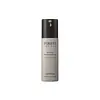What's inside
What's inside
 Key Ingredients
Key Ingredients

 Benefits
Benefits

 Concerns
Concerns

 Ingredients Side-by-side
Ingredients Side-by-side

Water
Skin ConditioningAlcohol Denat.
AntimicrobialAloe Barbadensis Leaf Juice
Skin ConditioningLinum Usitatissimum Seed Extract
PerfumingDiethylhexyl Malate
EmollientC12-15 Alkyl Benzoate
AntimicrobialPPG-26 Oleate
EmollientPrunus Amygdalus Dulcis Shell Extract
Skin ConditioningAlthaea Officinalis Root Extract
Skin ConditioningDisodium Cocoamphodiacetate
CleansingPhospholipids
Skin ConditioningBisabolol
MaskingPanthenol
Skin ConditioningTocopheryl Acetate
AntioxidantAloe Barbadensis Leaf Extract
EmollientDimethicone
EmollientAcrylates/C10-30 Alkyl Acrylate Crosspolymer
Emulsion StabilisingIsododecane
EmollientMyreth-3 Myristate
EmollientHexyldecyl Stearate
EmollientButylene Glycol
HumectantHamamelis Virginiana Extract
AntiseborrhoeicCarbomer
Emulsion StabilisingTriethanolamine
BufferingXanthan Gum
EmulsifyingTrisodium EDTA
Phenoxyethanol
PreservativeChlorphenesin
AntimicrobialWater, Alcohol Denat., Aloe Barbadensis Leaf Juice, Linum Usitatissimum Seed Extract, Diethylhexyl Malate, C12-15 Alkyl Benzoate, PPG-26 Oleate, Prunus Amygdalus Dulcis Shell Extract, Althaea Officinalis Root Extract, Disodium Cocoamphodiacetate, Phospholipids, Bisabolol, Panthenol, Tocopheryl Acetate, Aloe Barbadensis Leaf Extract, Dimethicone, Acrylates/C10-30 Alkyl Acrylate Crosspolymer, Isododecane, Myreth-3 Myristate, Hexyldecyl Stearate, Butylene Glycol, Hamamelis Virginiana Extract, Carbomer, Triethanolamine, Xanthan Gum, Trisodium EDTA, Phenoxyethanol, Chlorphenesin
Water
Skin ConditioningPropanediol
SolventDimethicone
EmollientGlycereth-26
Humectant1,2-Hexanediol
Skin ConditioningBis-PEG-18 Methyl Ether Dimethyl Silane
EmollientMannitol
HumectantMethyl Trimethicone
Skin ConditioningButylene Glycol
HumectantPPG-13-Decyltetradeceth-24
EmulsifyingHydroxyethyl Acrylate/Sodium Acryloyldimethyl Taurate Copolymer
Emulsion StabilisingPolysorbate 20
EmulsifyingCetearyl Alcohol
EmollientAcrylates/C10-30 Alkyl Acrylate Crosspolymer
Emulsion StabilisingParfum
MaskingTromethamine
BufferingGlyceryl Caprylate
EmollientGlyceryl Stearate
EmollientEthylhexylglycerin
Skin ConditioningStearic Acid
CleansingHydrogenated Lecithin
EmulsifyingPhenoxyethanol
PreservativeBiosaccharide Gum-1
HumectantDisodium EDTA
Polyglyceryl-3 Methylglucose Distearate
EmulsifyingSorbitan Isostearate
EmulsifyingGlycoproteins
Skin ConditioningAureobasidium Pullulans Ferment
Skin ConditioningBHT
AntioxidantPotassium Hydroxide
BufferingAcetic Acid
BufferingTocopherol
AntioxidantWater, Propanediol, Dimethicone, Glycereth-26, 1,2-Hexanediol, Bis-PEG-18 Methyl Ether Dimethyl Silane, Mannitol, Methyl Trimethicone, Butylene Glycol, PPG-13-Decyltetradeceth-24, Hydroxyethyl Acrylate/Sodium Acryloyldimethyl Taurate Copolymer, Polysorbate 20, Cetearyl Alcohol, Acrylates/C10-30 Alkyl Acrylate Crosspolymer, Parfum, Tromethamine, Glyceryl Caprylate, Glyceryl Stearate, Ethylhexylglycerin, Stearic Acid, Hydrogenated Lecithin, Phenoxyethanol, Biosaccharide Gum-1, Disodium EDTA, Polyglyceryl-3 Methylglucose Distearate, Sorbitan Isostearate, Glycoproteins, Aureobasidium Pullulans Ferment, BHT, Potassium Hydroxide, Acetic Acid, Tocopherol
Alternatives
Ingredients Explained
These ingredients are found in both products.
Ingredients higher up in an ingredient list are typically present in a larger amount.
Acrylates/C10-30 Alkyl Acrylate Crosspolymer is a synthetic polymer. It is used to thicken and improve the texture of products. Due to its properties, it can prevent water and oil ingredients from separating.
Butylene Glycol (or BG) is used within cosmetic products for a few different reasons:
Overall, Butylene Glycol is a safe and well-rounded ingredient that works well with other ingredients.
Though this ingredient works well with most skin types, some people with sensitive skin may experience a reaction such as allergic rashes, closed comedones, or itchiness.
Learn more about Butylene GlycolDimethicone is a type of synthetic silicone created from natural materials such as quartz.
What it does:
Dimethicone comes in different viscosities:
Depending on the viscosity, dimethicone has different properties.
Ingredients lists don't always show which type is used, so we recommend reaching out to the brand if you have questions about the viscosity.
This ingredient is unlikely to cause irritation because it does not get absorbed into skin. However, people with silicone allergies should be careful about using this ingredient.
Note: Dimethicone may contribute to pilling. This is because it is not oil or water soluble, so pilling may occur when layered with products. When mixed with heavy oils in a formula, the outcome is also quite greasy.
Learn more about DimethiconePhenoxyethanol is a preservative that has germicide, antimicrobial, and aromatic properties. Studies show that phenoxyethanol can prevent microbial growth. By itself, it has a scent that is similar to that of a rose.
It's often used in formulations along with Caprylyl Glycol to preserve the shelf life of products.
Water. It's the most common cosmetic ingredient of all. You'll usually see it at the top of ingredient lists, meaning that it makes up the largest part of the product.
So why is it so popular? Water most often acts as a solvent - this means that it helps dissolve other ingredients into the formulation.
You'll also recognize water as that liquid we all need to stay alive. If you see this, drink a glass of water. Stay hydrated!
Learn more about Water